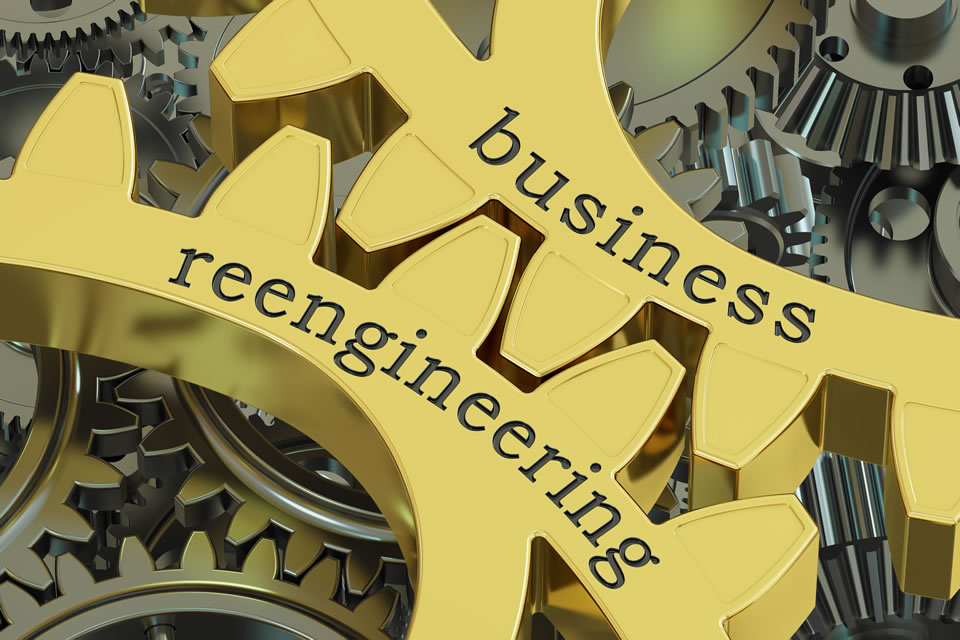Business Process Reengineering can be defined in many ways, including as:
- The fundamental rethinking and radical redesign of business processes to achieve dramatic improvements in critical contemporary measures of performance such as cost, quality, service and speed (Hammer & Champy).
- The analysis and design of workflows and processes within and between organisations. Business activities should be viewed as more than a collection of individual or even functional tasks; they should be broken down into processes that can be designed for maximum effectiveness, in both manufacturing and service environment. (Davenport).
- A management discipline, where the design of existing processes (within a company and between companies) and their business components are first analyzed and changed according to criteria of efficiency, economy, and value added to business objectives.
- Discovering how business processes currently operate, how to redesign these processes to eliminate the wasted or redundant effort and improve efficiency, and how to implement the process changes in order to gain competitiveness.
- Is … about rejecting the conventional wisdom and received assumptions of the past. … Reengineering is the search for new models of organizing work. Tradition counts for nothing. Re-engineering is a new beginning. … To succeed at reengineering, you have to be a visionary, a motivator, and a leg breaker (Hammer and Champy).
- The redesign of processes to take advantage of the enormous potential of information technology ( Gant).

The intent of business process of reengineering is to make organizations significantly more flexible, responsive, efficient, and effective for their customers, employees and other stakeholders.
When process of reengineering is applied, a business’s priorities must change in the following ways:
Downsizing or restructuring means doing less with less but on the other side BPR is doing more with less.
- From manager/owner to customer focus.
- From controlled workers to empowered, involved process owners and decision makers.
- From activity-based work to a results orientation.
- From scorekeeping to leading and teaching so that people measure their own results.
- From functional (vertical) to process (horizontal/cross functional) orientation.
- From serial to simultaneous
- From complex to simple.
- From status quo to inventing new systems and processes and looking toward the future.
One reason the change in BPR is radical rather than incremental is “to avoid being trapped by the way things are currently done” (Vidgen). BPR, therefore, is a technique that focuses on the processes that span an organisation, as opposed to being functionally or organizationally focused.Concept of reengineering cannot be reduced to processes alone because its principles are applied in all parts of an organization, and it has significant fundamental objectives. Companies use business process reengineering to improve performance substantially on key processes that impact customers.
The change management is an essential skill to facilitate the insertion of newly-designed processes and structures into working practices, and to deal effectively with resistance. This is considered to be a crucial component of any BPR effort.

The purpose of reengineering is to make all your processes the best-in-class.
Business processes are characterized by three elements:
- The inputs, (raw materials, knowledge, information).
- The processing (transformations which usually go through several stages and may turns out to be time and money consuming).
- The outcome (the delivery of the expected result).
We cannot improve or measure the performance of a hierarchical structure. But, we can increase output quality and customer satisfaction, improving processes reducing the cost and cycle time.
The problematic part of the process is processing. Business process reengineering mainly intervenes in the processing part, which is reengineered in order to become less time and money consuming.
Business process reengineering means to take everything from the beginning, from the foundation, to change fundamentally, drastically and dramatically.
For this, the business is reinventing itself from a blank sheet of paper that you put in front of you and begin to answer this questions: “Why exactly do we do what we are doing?” and “Why do we do it like this?”.
In the organizations where the management is asking: “How do we do it sooner?”, “How can we do it cheaper?” or “How can we do it better?” it gets to apply, in the end, only process improvements.
Quite often it is necessary for an organization to revise and re-examine its decisions, goals, targets etc., in order to improve the performance.
Most organizations are not process-oriented, they are focused on tasks, on jobs, on people, on structures, but not on processes.
The process – oriented organization has a number of benefits compared with the functional one, like:
Doing more with less requires redefining personnel roles and responsibilities, changing processes and systems, and refining service to customers.
- Making it possible for process managers to pursue the work flow across different company functional area.
- Helping in removing the barriers between departments totally or at least partially.
- Minimizing rivalry and quarrel between employees of different departments
- Encouraging cooperation between employees of various departments
- Coaching employees to understand the work.
The reengineering projects are designed on the specifics of each company. Process reengineering is not a standard, uniform and uniformly applicable in any field, it needs to take into account a multitude of variables specific to the company and the industry for which it is designed and implemented.

Process Reengineering Life Cycle includes six sequential stages:
- Envisioning new processes
- Initiating change
- Process diagnosis
- Process redesign
- Reconstruction
- Process monitoring
Business Process Reengineering refocuses company values on customer needs, redesigns core processes, reorganizes a business into cross-functional teams with end-to-end responsibility for a process, rethinking basic organizational and people issues and improving business processes across the organization.
Seven principles that could be used to reengineer and help streamline workflows, thus improving quality, time management and cost (Hammer and Champy).
- Organize around outcomes, not tasks.
- Identify all the processes in an organization and prioritize them in order of redesigning urgency.
- Integrate information processing work into the real work that produces the information.
- Treat geographically dispersed resources as though they were centralized.
- Link parallel activities in the workflow instead of just integrating their results.
- Put the decision point where the work is performed, and build control into the process.
- Capture information once and at the source.
Reasons why you should consider Business project reengineering

When applying the BPR management technique to a business organization the implementation team effort is focused on the following objectives:
- Customer focus. Customer service oriented processes aiming to eliminate customer complaints (waiting time reduction).
- Dramatic compression of the time it takes to complete a task for key business processes
Practical experience in organizations where process reengineering was implemented, shows the following: the quality was improved by 84%, production circle time was reduced by 35%, cost of product development decreased by 54% and profit increased by more than 35%.
Eric M. and M. Stefanovi
- Compression (task elimination/automation). Cutting major tasks of cost and capital, throughout the value chain.
- Process integration. Organizing the processes a company develops transparency throughout the operational level of reducing cost.
- Adaptive processes and structures to changing conditions and competition. Being closer to the customer the company can develop the awareness mechanisms to rapidly spot the weak points and adapt to new requirements of the market.
- Enthusiasm with the superior service and value to the customers. The level of quality is always the same controlled and monitored by the processes, and does not depend mainly on the person who is servicing the customer.
- Leadership through imaginative change of providing to an organization a competitive advantage.
- Improve drastically effectiveness and efficiency.
- Data quality/completeness.
Business process reengineering (BPR) should not be considered downsizing, restructuring, reorganization, and/or new technology. It is the examination and change of five components of the business: strategy, process, technology, organization, and culture.
Motivation for Reengineering
The motivations for reengineering and our engagement are many, including to:
- Reduce costs/expenses.
- Improve financial performance.
- Reduce external competition pressure.
- Reverse erosion of market share.
- Respond to emerging market opportunities.
- Improve customer satisfaction.
- Enhance quality of products and services.
- Be competitive.
- To cure systemic process and behavioral problems.
- Enhance organization capability to expand to other industries.
- To accommodate an era of change.
- To survive and be successful in the long term.
Business Process Reengineering benefits:

- Increased effectiveness. Identifying the core functions as well as any that are inefficient or outmoded.
- Meaningful work for staff. The process promotes greater staff involvement.
- Improved organizational performance. Decreasing new product and process activity time.
- Crystallize business focus.
- Business growth. Improving the industry position with radical improvements.
- Reduce costs and cycle time. Business process reengineering reduces costs and cycle times by eliminating unproductive activities and the employees who perform them. Reorganization by teams decreases the need for management layers, accelerates information flows, and eliminates the errors and rework caused by multiple hand offs.
- Improve quality. Business process reengineering improves quality by reducing the fragmentation of work and establishing clear ownership of processes. Workers gain responsibility for their output and can measure their performance based on prompt feedback.
- Make an organization more flexible, effective, and responsive to its customers, employees, and shareholders
One of the goals of BPR is to support a company organizational change in order to achieve viable improvements and raising of critical processes.
BPR involves innovation. Creating new products and services, as well as positive thinking are critical to the success of BPR.
After our engagement we need to determine whether a certain process within your organisation requires minor healing (continuous process improvement) or a major surgery (process reengineering).
In reality, a company cannot always improve on a continuous basis, because at a given point, improvement is either impossible, infeasible or extremely expensive. One, then has to innovate or reengineer. On the other hand, we cannot always reengineer either. Generally, after reengineering, it is necessary to debug, improve, refine and fine tune. At a given point, then continuous improvement has to be stopped and reengineering has to be taken up, if the company wants to remain competitive. This pattern applies to both products and services. Both continuous improvement and reengineering (innovation) are necessary to drive “breakthrough” in organisational performance. One should innovate, then improve, innovate, then improve again and so on and so forth.
Business Process Improvement vs Business Process Reengineering
Business process improvement begins by documenting what one does today, establishing some measures for process flow, measuring performance, and identifying and implementing improvement. Business process reengineering begins with defining the scope and objectives of the reengineering project, learning from customers, employees, competitors, and technology, creating a vision for the future and designing new business processes, creating a plan for action during the transition period, and implementing a solution. BPR efforts are far more comprehensive than those involved in business process improvement.
The essence of BPR is a radical change in processes, which differs from the typical BPI that is characterized by only symptomatic, gradual changes. Therefore, the defining characteristic of BPI, when compared to BPI and other methods of change management, is that it is a radical change and not a gradual improvement of processes. BPR is the analysis and redesign of workflow within a company and between companies.
So, the main difference between BPi and BPR is that BPI looks into ways to improve the processes in the existing structure whereas BPR strives for dramatic improvements so that the organization breaks away from conventional wisdom in such a way that the change becomes cross functional in scope after crossing all boundaries.